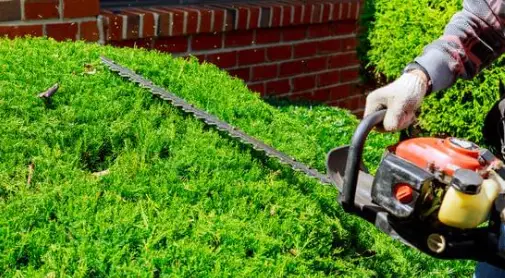Maintaining well-trimmed hedges is essential for a beautiful and tidy garden. Thinning overgrown hedges enhances the aesthetic appeal and promotes healthy growth. Of course, it is sometimes tricky to thin overgrown or unruly hedges, but help is available to ensure you achieve fantastic results with a hedge trimmer.
Whether you have flowered, formal, or informal hedges, Equipment Girl is on hand to offer tips and techniques which will help you achieve professional results.
Understanding Overgrown Hedges
Overgrown hedges can be identified by their height, width, and unruly appearance. Such hedges not only detract from the overall beauty of your garden but also cause issues like limited sunlight and air circulation. Neglect, favourable growing conditions, and lack of regular maintenance contribute to hedge overgrowth.
By understanding the signs and consequences of unkempt hedges, you can take timely action to restore their health and appearance.

Tools And Safety Precautions
Before you begin thinning your unseemly hedges, choosing the right time of year is essential. Early spring or late autumn is generally suitable to trim your hedge, considering the growth patterns of most hedge plants. Assess the condition of your hedge, identifying areas that need attention. Clear the work area of any obstacles or debris hindering your progress.
Before trimming hedges, taking safety precautions, such as wearing appropriate protective gear like gloves and goggles, and ensuring a clear work area is crucial.
Preparing For Hedge Trimming
To effectively thin messy hedges, you’ll need the right tools. Electric hedge trimmers, such as battery-operated ones or those with a long reach, are ideal for this task. Manual hedge-trimming tools like pruning saws and anvil cut shears may also be necessary for thicker branches. Our post “Best Hedge Trimmers For Thick Branches” maybe interest you. You can check it out.

Step-by-Step Guide To Thinning Overgrown Hedges
For the best results, follow these steps when thinning an overgrown hedge.
Assess The Hedge Thickness
Before you begin thinning your unkempt hedges, assessing the hedge’s thickness is crucial. This will help you determine the extent of thinning required and guide your trimming process.
Stand back and observe the hedge from different angles to view its density comprehensively. Look for areas where the foliage is excessively dense or light struggles to penetrate. You can effectively plan your thinning strategy by evaluating the hedge’s thickness before you trim your hedge.
Select The Appropriate Hedge Trimming Technique
Once you have assessed the hedge thickness, it’s time to choose the most suitable hedge-trimming technique. There are two primary techniques to consider: vertical or horizontal thinning. The choice between the two depends on the hedge’s natural shape and your desired outcome, particularly if you want formal hedges or informal hedges.
Vertical Thinning
This technique involves trimming the hedge vertically, removing excess growth from top to bottom. It helps create a more uniform appearance, ideal for formal hedges with a columnar or upright growth habit.
Horizontal Thinning
This technique focuses on trimming the hedge horizontally, removing branches from the sides to the centre. It is particularly effective for flowering hedges with a natural, informal shape or those that require a more layered and textured look.
Proper Hedge Trimming Techniques
For the best results, it’s essential to follow proper trimming techniques. Here are some fundamental approaches to keep in mind:
Use Electric Hedge Trimmer
Opt for an electric hedge trimmer for efficient and precise trimming. Electric trimmers provide the necessary power to cut through thicker branches and ensure a clean and even finish. Choose a hedge trimmer with a sharp and durable blade that suits the size and density of your hedge. You can also check out our post “Best Hedge Trimmer Brands” for more additional insights.
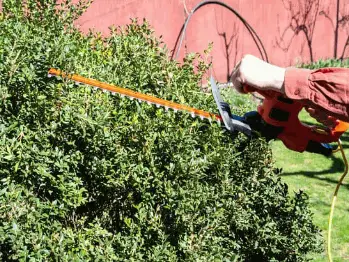
Make Slightly Angled Sweeping Cuts
When trimming branches, make slightly angled sweeping cuts. This technique promotes better regrowth and a natural appearance. Angle the hedge trimmer blade slightly away from the hedge, creating a gentle slope on the trimmed surface. This angled cut allows sunlight to reach the lower parts of the hedge and encourages healthy growth. For more information check out our post “How To Clean Hedge Trimmer Blades“.
Cut In Small Sections
Working on the hedge in manageable sections is essential to avoid damaging its structure. Start at one end of the hedge and work systematically, trimming small areas at a time. This approach ensures you control the trimming process and allows for more precise shaping.
Remove Dead Or Overgrown Stems
As you thin the hedge, identify and remove any dead or overgrown stems. These stems detract from the hedge’s appearance and can hinder its overall health. Use pruning shears or a pruning saw to cut away any dead or excessively thick branches carefully. Removing these stems will improve the hedge’s vitality and encourage new growth.
Achieve A Balanced And Natural Look
To create a balanced and natural look when trimming hedges, pay attention to the following hedge-trimming tips:
Maintain Symmetrical Growth
While thinning, trim the overgrown hedge to maintain a balanced and uniform appearance. Step back occasionally to assess the symmetry and adjust your trimming as needed. This approach creates an aesthetically pleasing and well-maintained hedge.
Shape The Hedge
Carefully shape the hedge according to your preferences and the desired form. Use the hedge trimmers to sculpt the hedge into the desired shape, whether a geometric pattern or a more organic form. Take your time and make precise cuts to achieve the desired outcome. Our post “How To Use A Hedge Trimmer For Shaping” maybe interest you. You can check it out.
Trim Lower And Inner Branches
To allow sunlight to reach the lower parts of the hedge, trim excessive growth and inner branches. This ensures that the entire hedge receives adequate light and promotes healthy growth from top to bottom. Be cautious not to over-prune the lower branches, as they provide structure and density to the hedge.
Trim Tall Hedges With Long-Reach Hedge Trimmers
For tall hedges that are challenging to reach, long-reach hedge trimmers are the ideal tools. These trimmers have extended handles allowing you to access and trim the upper portions effectively. With a long-reach trimmer, you can maintain consistency and achieve an even finish throughout, when you trim your hedge. To learn more about what is a long-reach hedge trimmer, take a look at our post.
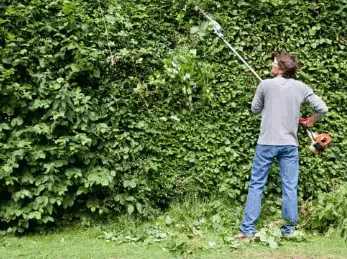
Final Touches And Clean-up
After completing the hedge trimming process, perform any final adjustments to ensure a polished appearance. Step back and assess the overall result, making any necessary trims or shaping to perfect the hedge’s form. Additionally, clean up the work area by removing any trimmings and debris. Dispose of the hedge trimmings responsibly by recycling, composting, or using green waste bins.
Following these step-by-step instructions and techniques, you can successfully thin large hedges and achieve a beautifully trimmed and well-maintained hedge for your garden.
Dealing with Hedge Trimmings
After you thin or trim hedges, proper handling and disposal of the resulting overgrown hedge trimmings are crucial for maintaining a clean garden and promoting environmental sustainability. Several methods can be employed to deal with hedge trimmings effectively:
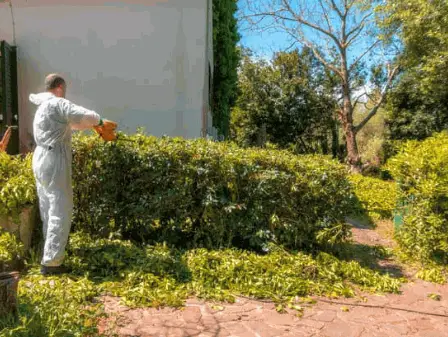
Green Waste Bins
Check if local waste management authorities provide green waste bins or organic waste collection services. These bins are for garden waste, including hedge trimmings, and ensure proper disposal through composting or eco-friendly processes.
Recycling
Research local recycling centres or composting facilities in your area that accept organic materials, including hedge trimmings. Recycling trimmings help divert them from landfills and allows for their transformation into valuable compost or mulch.
Reusing As Mulch Or Compost
Hedge trimmings are great for mulch or compost in your garden. Mulching involves spreading the trimmings on the soil surface to retain moisture, suppress weeds, and regulate temperature. Composting them with other organic materials accelerates decomposition, resulting in nutrient-rich compost for improving soil quality.
Wood Chipping
If you can access a wood chipper, transform the hedge trimmings into wood chips. You can use these chips for pathways, garden bed borders, or as a mulch layer. Alternatively, consider donating chipped trimmings to local community gardens, landscaping companies, or farms.
Awareness of specific regulations in your region regarding garden waste disposal is essential. Ensure the trimmings are free from invasive plants or pests before disposal or reuse.
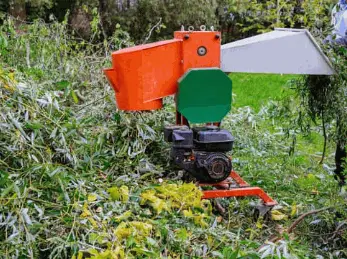
Aftercare And Maintenance
Aftercare and regular hedge maintenance are essential for thinned hedges’ long-term health and beauty. Ensure adequate watering, especially during dry periods, to support their regrowth. Fertilise the hedges with a balanced, slow-release fertiliser in spring or late autumn.
Monitor for pests and diseases and take prompt action to prevent further damage. Regularly prune and shape the hedges to maintain their desired form and promote denser growth.
Apply a layer of organic mulch around the base of the hedges to retain moisture and suppress weeds. Conduct regular inspections and promptly address any issues for your hedges’ overall well-being.
With proper watering, fertilisation, pest and disease control, pruning, and mulching, you’ll be able to enjoy beautiful hedges that enhance the aesthetics of your garden for years to come.
Frequently Asked Questions
Some of the most frequently asked questions on the topic of thinning overgrown hedges are listed and answered below:
How Often Should Hedges Be Thinned?
The frequency of hedge thinning depends on the specific hedge type and its growth rate. As a general guideline, thin hedges once or twice a year. However, fast-growing hedges may require more frequent thinning for controlled growth, while slower-growing hedges may need thinning every two to three years. Regular monitoring of the hedge’s density and appearance will help determine the appropriate timing for thinning.
Can Hedge Trimming Be Done During Any Season?
You can thin or trim hedges throughout the year, but the ideal timing depends on the specific hedge and its growth characteristics. For most hedges, the best time for trimming is during their dormant period, typically in early to late autumn or early spring.
Trimming during these seasons helps promote vigorous regrowth and minimises plant stress. However, it’s essential to check the specific requirements for your hedge type, as some flowering hedges may have different preferred pruning times.
What Are The Best Hedge Trimmers For Different Hedge Types?
The choice of hedge trimmers depends on the hedge type and its size. Here are a few tools for different hedge types:
Electric Hedge Trimmer: A durable hedge trimmer is versatile and suitable for most hedge types. They provide efficient cutting power, are perfect for particularly thick branches, and are ideal for small to medium-sized hedges.
Battery Hedge Trimmer: A battery hedge trimmer offers cordless convenience and is suitable for hedges that require mobility or sit far from power sources. Our post “Battery Hedge Trimmer VS Petrol” maybe interest you. You can check it out.
Long-Reach Hedge Trimmer: A long-reach hedge trimmer has extended reach capabilities, making them suitable for trimming tall hedges and reaching higher branches.
Manual Hedge Trimming Tools: For smaller hedges or intricate shaping, manual tools like pruning shears and saws can provide precision and control, especially with thinner branches.
Should I Hire A Professional For Hedge Thinning?
Whether to hire a professional for hedge thinning depends on various factors, such as the size of the hedge, your experience and expertise, and the complexity of the task. Hiring a professional can benefit large, tall, or intricately shaped hedges requiring specialised equipment and skills. Experts can also carefully manage the process of trimming mature hedges, which requires additional care.
However, if you have smaller hedges and feel confident in your abilities, you can undertake the thinning process by following proper techniques and safety precautions with a hedge trimmer. For more learnings, you can check out our post “Hedge trimmer safety tips“.
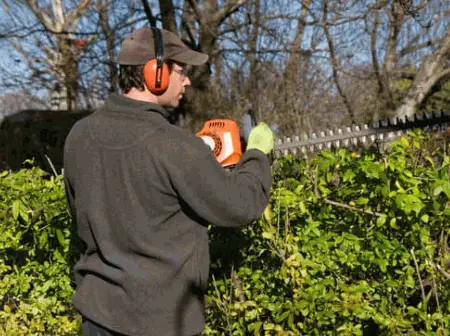
Anyone Can Trim Hedges But Not Everyone Does It Well
Thinning overgrown hedges with a hedge trimmer is an essential gardening skill that improves your garden’s overall appearance and promotes your hedges’ health. Following the step-by-step guide and using the appropriate tools can achieve symmetrical and well-maintained hedges.
Regular and ongoing maintenance and proper aftercare of your hedge trimmer encourage new growth in young hedging plants, ensure that your hedges remain vibrant, and enhance the beauty of your entire garden.
Equipment Girl is keen to ensure you enjoy a great-looking garden and get the best return from all your devices and equipment, so stay in touch for more information on maintaining hedges in your garden.

